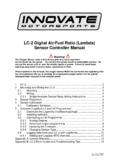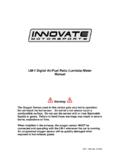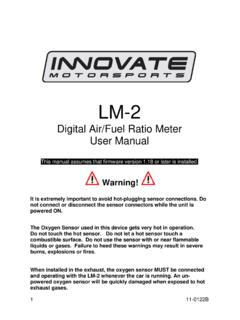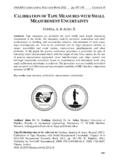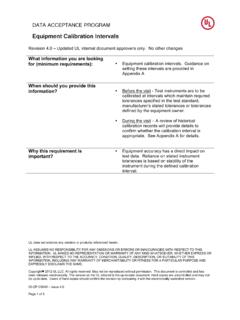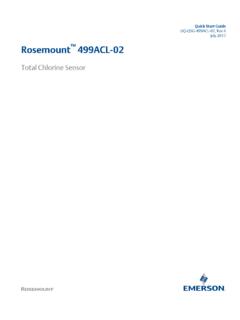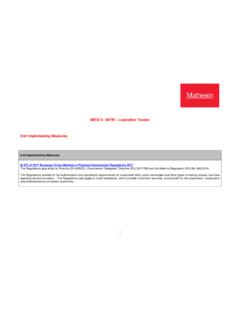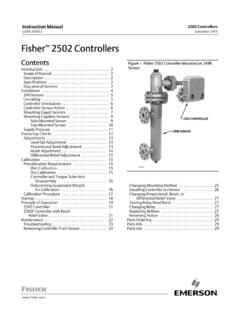Transcription of LC-1 Digital Air/Fuel Ratio (Lambda) Sensor Controller Manual
1 Document # 11-0053 11-0053 LC-1 Digital Air/Fuel Ratio (Lambda) Sensor Controller Manual Warning! The Oxygen Sensor used in this device gets very hot in operation. Do not touch the hot Sensor . Do not let a hot Sensor touch a combustible surface. Do not use the Sensor with or near flammable liquids or gases. Failure to heed these warnings may result in severe burns, explosions or fires. When installed in the exhaust, the oxygen Sensor MUST be connected and operating with the LC-1 whenever the car is running. An un-powered oxygen Sensor will be quickly damaged when exposed to hot exhaust gases. 1 Overview .. 2 2 Wiring and Mounting the LC-1 .. 3 Mounting .. 3 Wiring .. 3 Single Innovate Device Relay Wiring Instructions .. 4 Sensor Placement.
2 5 3 Sensor Calibration .. 6 Heater Calibration .. 6 Free Air Calibration .. 6 Calibration Schedule .. 7 4 Programming the LC-1 .. 7 Installing the LM Programmer Software .. 7 Hooking up the LC-1 device to the computer .. 7 Resetting the calibration data .. 8 Updating the Firmware .. 8 Programming the analog outputs .. 9 Advanced output programming .. 10 Appendix A: LED blinking codes .. 10 Appendix B: LC-1 Error Codes and Troubleshooting Tips .. 11 Appendix C: Limited Warranty .. 12 - 2 - 1 Overview The LC-1 is a stand-alone Wideband Controller used to measure the Air/Fuel Ratio (AFR) or Lambda for an engine. For gasoline-driven engines, the theoretically optimal air fuel Ratio is pounds of air for every pound of fuel.
3 At this Ratio , theoretically, all available oxygen in the air combines with all available fuel. This Ratio is called the stoichiometric Ratio . Stoichiometric for different fuels are as follows: Gasoline LPG (Propane) Methanol Ethanol CNG Diesel The measurement Lambda is the actual air fuel Ratio over the stoichiometric Ratio . A Lambda measurement of 1 equates to the air fuel Ratio of (for gasoline engines). When Lambda is less than 1 the engine runs rich , , unburned fuel exists in the exhaust stream. If lambda is greater than 1 the engine runs lean, , free oxygen (02) is present in the exhaust. Depending on the engine, maximum power is typically delivered when the engine runs slightly rich (for example at lambda values of to for most engines).
4 This instrument provides a means to measure the actual air fuel Ratio or lambda in the engine in operation directly from the exhaust. For this a special wide-band oxygen Sensor is used to measure the lambda value derived from the oxygen content (or lack thereof) of the exhaust gases. - 3 - 2 Wiring and Mounting the LC-1 Mounting 1. Find a suitable location under your vehicle where the LC-1 body can be mounted. Using zip ties or other suitable method, fasten the body of the LC-1 device securely to the frame-rails or other mounting points as far away from the heat of the exhaust system as the Sensor cable allows. DO NOT zip-tie the LC-1 by the cables. 2. Route the cables from the LC-1 (except Sensor cable) into the car interior under the dash.
5 In addition to isolating the LC-1 from heat sources, the unit and it s corresponding cables should also be isolated from all ignition and/or other potential RF emitting sources. Wiring The LC-1 has 6 stripped wires, a serial IN, and a serial OUT port. 1 Connect the RED wire to a switched 12V source in your car. A switched 12V source goes ON as soon as the ignition on the car is on. The circuit to which you will pull power from should be able to support an additional 3 amp draw. Make sure the connection is fused with a minimum fuse size of 5A. Circuits that share power with the vehicle s stereo, ignition system, ECU, lighting, or fuel pump should not be used. When in doubt, create an additional circuit using an automotive relay available at any automotive parts supplier.
6 See the next section for a relay installation diagram. 2 The BLUE and WHITE wires should all be grounded together to a solid ground source. The best possible ground source would be the battery ground (-) post. * If you have an LC-1 with 7 stripped connect the additional green wire to the same ground source as the blue and white wires. If other Innovate Motorsports devices are going to be daisy-chained along with the SCG-1, it is recommended that all devices be connected to a single ground point, ideally the battery ground (-) post. 3 Connect the LED and momentary pushbutton between the LC-1 s BLACK calibration wire and ground. Connect the red wire (Anode) of the included LED AND one side of the push button to the calibration wire (black) of the LC-1.
7 Connect the black wire (Cathode) of the LED AND the other side of the push button to ground (preferably to the same ground point as the blue and white wires.) Refer to the schematic below. - 4 - Note: The LED will fit a 5/32 ( - ) hole size and a panel thickness of 28 16gauge ( - ). 6. Optionally, the YELLOW (Analog out 1) and/or BROWN (Analog out 2) can be connected to the analog inputs of other devices such as data loggers, ECUs, or gauges. If either one or both of these wires are not being used, isolate and tape the wire(s) out of the way. The analog outputs can be programmed, see chapter titled Programming the Analog Outputs . The default analog outputs are as follows: Analog output one is = 14 AFR and .1V = 15 AFR. Analog output two is setup as 0V = AFR and 5V = AFR.
8 The analog outputs can be programmed with the provided software Note: The LC-1 s heater ground and system ground wires should share the same grounding location as the device to which you are feeding the analog outputs to. Single Innovate Device Relay Wiring Instructions - 5 - Sensor Placement Optimum bung placement will vary from application to application, but using the guidelines below will ensure the longest Sensor life with the most accurate readings. Using a bung is the preferred method for mounting the oxygen Sensor in all applications. Weld the bung at least 24 inches after the turbocharger. Using a clock as reference, mount the bung between the 9:00 o clock and 3:00 o clock position. Welding the bung in the lower section of the exhaust pipe can result in Sensor damage caused by condensation making contact with the Sensor s internal heating element.
9 A 1 bung (provided in the kit) will best protect the Sensor . When fully threaded, the Sensor s tip will sit flush with the inside of the exhaust piping, this does not adversely effect the readings. The bung should always be welded before the Catalytic Converter. Welding the bung after the catalytic converter will skew the readings toward lean. The skew in readings will vary with engine load and the efficiency of the catalytic converter. Leaded fuel and two stroke applications will reduce the Sensor s life. There are many other factors that dictate the Sensor s lifespan so it is impossible to predict total Sensor longevity. Exhaust leaks, camshaft overlap, and open (shorty) exhausts will cause false lean readings at light engine loads.
10 Typically, once the engine is under load and the exhaust gas volume increases, you will see accurate readings. When installed in the exhaust, the oxygen Sensor must be connected to a powered, functional SCG-1 (no error codes) whenever the engine is running. An un-powered Sensor will be damaged in a short period of time when exposed to exhaust gas. Do not pre-warm the Sensor before starting the engine, start the engine as you normal would. Allowing the Sensor to pre-warm before starting the engine will increase the possibility of damaging the Sensor from shock-cooling. The maximum temperature of the Sensor at the bung (the Sensor mounting location) should not exceed 500 oC or 900 oF. If these temperatures are exceeded in your application you should install the Innovate Motorsports HBX-1 heat sink bung extender.




